Country guides

Things to do in Japan
Home to pink cherry blossoms, sushi, and manga comics, Japan is a cultural explosion of historic attractions, neon-lit cities, and exquisite mountainous landscapes. Thankfully, this mystical country retains plenty of its ancient charm resulting in an experience of a lifetime.
Visitors should head to the capital Tokyo for a spot of shopping, to sample authentic Japanese cuisine, and maybe even enjoy a little karaoke. Though famous for its glitz and neon glam, this impressive modern metropolis also has ancient shrines and temples round just about every corner, making the sightseeing a wonderful combination of old and new.
The city of Hiroshima is the country's most famous tourist destination, as it's where thousands of visitors make a pilgrimage to Hiroshima's Peace Memorial Park, taking in the museums and lively city that have emerged triumphantly from the horror of the atomic bomb dropped during World War II. Hiroshima is a must for anybody interested in modern history and is a deeply moving place to visit.
Once visitors have had enough of Japan's cities, they can visit the countryside and witness picturesque volcanoes, take a dip in the hot springs, and explore the mountainous interior of the islands. Japan is a beautiful country and even in the cities the parks are punctuated with cherry blossom trees and mathematically correct Zen gardens that never cease to amaze foreigners.
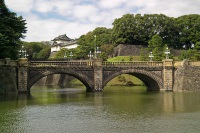
Tokyo Imperial Palace
Japan's Imperial Palace is regarded as the heart and soul of Tokyo, and stands on a huge site that still bears the remains of Edo Castle, stronghold of the Tokugawa Shogunate. The
Tokyo Imperial Palace
Japan's Imperial Palace is regarded as the heart and soul of Tokyo, and stands on a huge site that still bears the remains of Edo Castle, stronghold of the Tokugawa Shogunate. The present palace was completed in 1888 and is still home to the emperor of Japan.
The palace is off-limits but its grounds and surrounds provide a much-needed green space for the city with Higashi Gyoen, site of the Edo Castle Keep, open to the public. On January 2nd and December 23rd each year, visitors are able to enter the inner grounds and see the imperial family make public appearances from the balcony.
Guided tours of the palace are offered but only in Japanese, although an English pamphlet and audio guide are provided. These tours must be reserved in advance through the Imperial Household Agency.
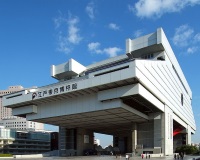
Edo-Tokyo Museum
This museum details the 400-year history of Tokyo from its beginning as a sleepy village called Edo to its time as a feudal capital, and its ultimate emergence as a modern megacity…
Edo-Tokyo Museum
This museum details the 400-year history of Tokyo from its beginning as a sleepy village called Edo to its time as a feudal capital, and its ultimate emergence as a modern megacity. Exhibits include architectural models and life-size replicas such as an ancient Kabuki theatre, original and recreated maps, photographs, woodblock prints and portrayals of the lives of the city's merchants, craftsmen and townspeople in days gone by.
There are numerous interactive exhibits and many intricate models with such wonderful detail that binoculars are provided for visitors to better appreciate them; traditional performances are held in the recreated theatre. Travellers should note that the museum will be closed for renovations until 2025.
Website www.edo-tokyo-museum.or.jp
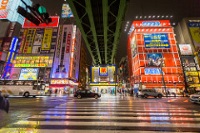
Akihabara
In a small area west of Akihabara Station lies a bright cluster of electronics shops, manga and anime stores, and video game outlets. The suburb has been specialising in electrical…
Akihabara
In a small area west of Akihabara Station lies a bright cluster of electronics shops, manga and anime stores, and video game outlets. The suburb has been specialising in electrical equipment since the 1930s and is now regarded as the world's biggest and best electrical equipment enclave. Although the cheap and impressive technology draws many visitors, this is also a paradise for gamers and anime fans, with shops full of merchandise and numerous arcades. The arcades carry everything new and novel but also have many of the vintage games that are difficult to find these days.
Website www.akiba.or.jp/english/index.html
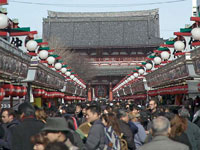
Senso-ji Temple
The Asakusa neighbourhood in Tokyo draws visitors to admire the city's oldest temple, Senso-ji, founded in 628. The story goes that two brothers fishing in the nearby river netted …
Senso-ji Temple
The Asakusa neighbourhood in Tokyo draws visitors to admire the city's oldest temple, Senso-ji, founded in 628. The story goes that two brothers fishing in the nearby river netted a golden image of Kannon, the Buddhist goddess of mercy, and the statue kept turning up in their nets no matter how many times they threw it back. The brothers were inspired to enshrine it in a temple dedicated to the deity. The statuette is still inside, but never shown to the public, though pilgrims flock here every day seeking the favour of the goddess. For many visitors, the temple is one of the highlights of a visit to Tokyo, while the nearby Demboin Garden is a good spot to relax.
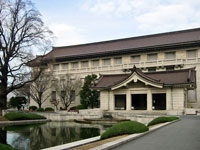
Tokyo National Museum
Close to Ueno Station and enclosed in the beautiful, spacious Ueno Imperial Gift Park, the National Museum is host to the largest collection of Japanese art in the world. Exhibits …
Tokyo National Museum
Close to Ueno Station and enclosed in the beautiful, spacious Ueno Imperial Gift Park, the National Museum is host to the largest collection of Japanese art in the world. Exhibits range from antique kimonos and delicate pottery to woodblock prints and archaeological finds.
The vast collection is displayed on a rotating basis with at least 4,000 artefacts visible at any time, so the museum always has something new to offer. The museum consists of five different buildings containing many galleries, so visitors need sufficient time to do it justice.
The Imperial Gift Park is a lovely place to enjoy a stroll, and there are shaded areas to rest. The grounds also contain big ponds and some other cultural institutions, including a zoo, the Metropolitan Art Museum, Bunka Kaikan Cultural Hall, the Western Art Museum, and the National Science Museum. There should be something here to interest the whole family and all the educational attractions can easily fill a whole day of sightseeing.
Website www.tnm.jp/?lang=en
Mount Fuji
The dormant volcano of Mount Fuji has been revered since ancient times, its symmetrical 12,388-foot (3,776m) snow-crowned summit as symbolic as the country's own flag. It features …
Mount Fuji
The dormant volcano of Mount Fuji has been revered since ancient times, its symmetrical 12,388-foot (3,776m) snow-crowned summit as symbolic as the country's own flag. It features in poetry and art through the ages and is considered a holy site in Japanese culture. The highest mountain in Japan, it has many historical and mythological associations, with ancient samurai using the base of the mountain as a remote training area. The closest town to the volcano is Fuji Yoshida, from which buses leave frequently for the most popular hiking routes. There are six trails to the summit, of which the Kawaguchiko Trail is the easiest, being quite manageable even for children and the elderly.
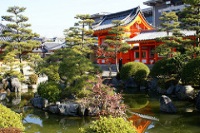
Sanjusangen-do
Once part of a large Buddhist temple complex known as the Lotus King Temple, the temple of Rengeoin is better known by its popular name of Sanjusangen-do. Inside the longest wooden…
Sanjusangen-do
Once part of a large Buddhist temple complex known as the Lotus King Temple, the temple of Rengeoin is better known by its popular name of Sanjusangen-do. Inside the longest wooden building in Japan stands row upon row of life-sized statues of Kannon, the goddess of mercy. They're carved from Japanese cypress and covered in gold leaf, dating back to the 12th and 13th centuries.
There are 1,000 statues and each is unique, bearing a religious symbol or gesture. They surround the large, central figure of a seated Kannon, carved in 1254 in the Kamakura Period. All the golden statues create a hypnotic yellow haze, giving credence to the local myth that if visitors stare at them for long enough one of the statues will assume the form of a loved one.
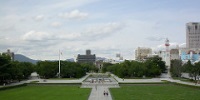
Peace Memorial Park
A complex of buildings and monuments was erected in the Peace Memorial Park, which lies around the epicentre of the 1945 atomic bomb explosion in Hiroshima. Central to the park is …
Peace Memorial Park
A complex of buildings and monuments was erected in the Peace Memorial Park, which lies around the epicentre of the 1945 atomic bomb explosion in Hiroshima. Central to the park is the only remaining building damaged in the blast, now known as the Atomic Bomb Dome.
The park also contains the Peace Memorial Museum, where visitors will find exhibits portraying the horrors of the bomb. Between the museum and the dome stands the Memorial Cenotaph. It has a stone chest that contains a list of all those killed in the explosion or who died from radiation poisoning.
The Cenotaph also houses the peace flame, which burns until nuclear war is no longer considered a threat to humanity. Other monuments include the Statue of the A-Bomb Children and the Atomic Bomb Memorial Mound, which holds the ashes of tens of thousands of unidentified victims.
Website www.pcf.city.hiroshima.jp/index_e2.html
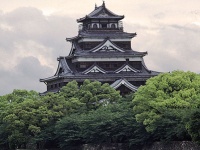
Hiroshima Castle
Hiroshima's original castle was totally destroyed in the atomic blast but has been reconstructed as a replica. When the castle was established by a feudal lord in 1589, Hiroshima d…
Hiroshima Castle
Hiroshima's original castle was totally destroyed in the atomic blast but has been reconstructed as a replica. When the castle was established by a feudal lord in 1589, Hiroshima didn't exist; the city that grew around the fortress took its name. At the time, the area was called Gokamura, meaning five small villages, and the lord ruled over a vast territory spanning nine provinces from the stronghold.
The castle now houses a museum detailing the region's history up until World War II and particularly the historic feudal system. The exhibits include some models of ancient Hiroshima and some traditional costumes to try on; visitors will find great lookout spots and tranquil grounds.
Mount Aso
The volcanic Mount Aso lies almost in the centre of Kyushu Island and is Japan's biggest active volcano. Its caldera stretches about 11 miles (18km) from east to west, and 15 miles
Mount Aso
The volcanic Mount Aso lies almost in the centre of Kyushu Island and is Japan's biggest active volcano. Its caldera stretches about 11 miles (18km) from east to west, and 15 miles (24km) from north to south, making it one of the largest in the world.
While one of its volcanic peaks (Naka) is still active and regularly emits smoke and ash, the rest of the landscape inside the caldera is beautifully green, with horses, livestock and several towns. In the city of Aso there is a museum dedicated to the volcano that is worth visiting for those interested in the region's remarkable geology. There is a cableway up to the Mount Aso crater lake that allows visitors to see the steaming turquoise water up close.
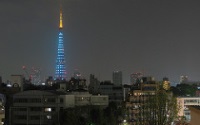
Tokyo Tower
Modelled after the Eiffel Tower, the Tokyo Tower is more colourful and serves a technological purpose. Functioning chiefly as a television and radio antenna, it's also one of the c…
Tokyo Tower
Modelled after the Eiffel Tower, the Tokyo Tower is more colourful and serves a technological purpose. Functioning chiefly as a television and radio antenna, it's also one of the city's premier landmarks and a proud symbol of Japanese culture. At 1,091 feet (332m), it's the tallest structure in Tokyo and a great vantage point from which to take in the city.
There are two observation decks in the tower, both with magnificent 360 degree panoramic views. At the base of the tower is the four-storey FootTown where visitors will find restaurants, the Guinness Book of World Records Museum, an aquarium, theme park rides and the Gallery DeLux, a display of holographic technology and imagery.
Website www.tokyotower.co.jp/en/
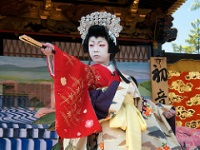
Minamiza Kabuki Theatre
Kabuki is a traditional Japanese dance-drama known for its stylised performance and the elaborate make-up worn by some performers. It enjoyed a golden age in the late 17th and earl…
Minamiza Kabuki Theatre
Kabuki is a traditional Japanese dance-drama known for its stylised performance and the elaborate make-up worn by some performers. It enjoyed a golden age in the late 17th and early 18th centuries, and today is the most popular style of traditional Japanese drama.
While there are many wonderful places in Japan to view kabuki theatre, the Kyoto Minamiza Theatre is one of the principal venues for such performances and a major hub for the art form. The building itself is an architectural wonder, built in a traditional style in 1929, on the edge of the Geisha district of Gion.
Website www.kabuki-bito.jp/eng/top.html


